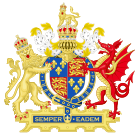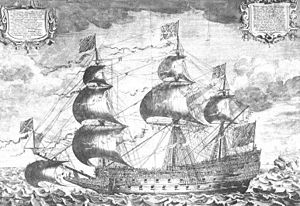Admiralty in the 17th century facts for kids
 |
|
| Office overview | |
|---|---|
| Formed | 1414 |
| Preceding Office |
|
| Dissolved | 1707 |
| Superseding agency | |
| Jurisdiction | Parliament of England |
| Headquarters | Admiralty Building Whitehall London Kingdom of England |
| Office executive | |
| Parent Office | Privy Council of England |
The Admiralty and Marine Affairs Office was a very important government office in England. It helped change the English Navy from a group of ships, some owned by the King and some private, into a strong, professional fighting force called the Royal Navy. This happened during the 17th century, from the early 1600s to the early 1700s.
The office made sure the Navy had regular money. It also made sure the Navy used only special warships and had trained officers. These officers had clear career paths, unlike before when sailors and former soldiers often mixed.
Contents
History of the Admiralty Office
After 1603, the English and Scottish navies joined together under King James I. However, the Navy slowly became less effective, and there was a lot of corruption. An investigation in 1618 helped fix these problems.
King James I made peace with Spain, and privateering (when private ships attacked enemy ships for profit) was stopped. Between 1618 and 1628, a special Navy Commission temporarily took over from the Navy Board. This was because some officials were misusing public money.
After the investigation, the job of the Lord High Admiral was brought back. The Duke of Buckingham held this role, but he was later murdered. Then, King Charles I decided to put the office "into commission." This meant a group of people, called the Board of Admiralty, managed the Navy instead of one person. This Board was basically the King's Privy Council in a new form.
The Admiralty Court, which handled sea laws, also became separate from the Lord High Admiral's direct control. The Lord High Admiral's job was brought back for a short time in 1638. But after 1679, the Lords Commissioners of Admiralty became the permanent group in charge of running the Navy.
Admiralty of England
The Admiralty of England was the main part of the government that managed the Navy. It oversaw everything from top commanders to daily operations.
These were the main rulers who were in charge of the Navy during this time:
- Queen Elizabeth I
- King James I & VI
- King Charles I
- Lord Protectors, Oliver Cromwell, Richard Cromwell (during the time England was a republic)
- King Charles II
- King James II & VII
- King William III and Queen Mary II
- Queen Anne
These were key positions in the Navy's leadership:
- Office of the Lord High Admiral of England: The highest naval officer.
- Vice-Admiral of England and Deputy Lord High Admiral: The second in command.
- Rear-Admiral of England: A senior officer below the Vice-Admiral.
- Vice-Admiral of England and Deputy Lord High Admiral: The second in command.
From 1628 to 1679, the Secretary of State made all the big decisions for the government regarding the Navy, especially during wartime.
Board of Admiralty
The Board of Admiralty, or the Lords Commissioners, were the group of people who managed the Navy.
- The Board of Admiralty: The main governing body.
First Commissioner and First Lord of the Admiralty
- First Lord of the Admiralty: This person was the head of the Board and a member of the English government.
- Clerk of the Admiralty: Helped with paperwork.
- Messenger of the Admiralty: Delivered messages.
- Housekeeper of the Admiralty: Managed the Admiralty building.
- Doorkeeper of the Admiralty: Guarded the doors.
- Gardner of the Admiralty: Looked after the gardens.
- Clerk of the Admiralty: Helped with paperwork.
Civil Commissioner
- Chief Secretary to the Admiralty (1628 – 1652)
- First Secretary to the Admiralty (1652 – 1871): This person was a key administrator.
Naval Commissioner
- Naval Lord (1682 – 1689)
- Senior Naval Lord (1689–1771)
Lords Commissioners of the Admiralty Many different commissioners served on this board during the 17th century. They were responsible for the Navy's administration.
Senior Leadership
This was the top command structure for naval operations:
- Office of the Lord High Admiral of England (1600 – 1628)
- Office of the Vice-Admiral of England
- Office of the Rear-Admiral of England
- Office of the Vice-Admiral of England
- Office of the First Lord of the Admiralty (1628 – 1964)
- Office of the Naval Lord of the Admiralty*
- Greenwich Hospital: A home for retired sailors.
- Nautical Almanac Office: Produced navigation guides.
- Royal Observatory: Studied stars for navigation.
- Office of the Naval Lord of the Admiralty*
Fleet Commands
These were the senior officers who commanded groups of ships:
- Admiral of the Fleet Red
- Vice-Admiral of the Red
- Rear-Admiral of the Red
- Vice-Admiral of the Red
- Admiral of the White
- Vice-Admiral of the White
- Rear-Admiral of the White
- Vice-Admiral of the White
- Admiral of the Blue
- Vice-Admiral of the Blue
- Rear-Admiral of the Blue
- Vice-Admiral of the Blue
Commanders of Fleets and Stations
These officers were in charge of naval forces in specific areas or bases.
Home Commands
- Admiral Commanding, the Narrow Seas: In charge of the waters between England and mainland Europe.
- Admiral/Vice-Admiral Commanding, in the Channel: In charge of the English Channel.
- Commander-in-Chief, the Downs: In charge of a key anchorage off the coast of Kent.
- Commander-in-Chief, Portsmouth: In charge of the important naval base at Portsmouth.
- Commander, Royal Squadron: In charge of the ships used by the Royal Family.
- Commander-in-Chief, Western Squadron: In charge of the fleet in the western seas.
Shore Commands
- Vice-Admiralties of the Coast: These officers were responsible for naval matters along the coastlines of England, Scotland, Ireland, and Wales. They handled things like captured pirate ships and shipwrecks.
Overseas Commands
- Commander-in-Chief, Jamaica Station: In charge of naval forces in Jamaica.
- Commander-in-Chief, Mediterranean Fleet: In charge of naval forces in the Mediterranean Sea.
Fleet Units
This table shows the different types and numbers of ships in the Navy between 1649 and 1690.
| Composition of the Navy between 1649-1690 | |
| Type of Ship | Number of Ships |
| Ships of the Line (1st rate) | 7 |
| Ships of the Line (2nd rate) | 11 |
| Ships of the Line (3rd rate) | 40 |
| Ships of the Line (4th rate) | 19 |
| Ships of the Line (5th-6th rate) | 26 |
| Captured enemy ships | 10 |
| Sloops (small warships) | 22 |
| Armed merchant ships | 29 |
| Flyboats (cargo ships) | 28 |
| Galliots & hoys (small boats) | 22 |
| Fireships (ships used to set enemy ships on fire) | 111 |
| Bomb vessels (ships with mortars for bombarding land) | 17 |
| Hospital ships | 4 |
| Yachts (for pleasure or transport) | 25 |
| Total Ships in Service | 361 |
Squadrons: Large groups of ships that operated together.
- Red Squadron
- White Squadron
- Blue Squadron
This section explains how the Navy got its weapons, supplies, and how its ships were built and repaired.
Board of Ordnance
The Board of Ordnance was in charge of all weapons, gunpowder, and military supplies for both the Army and Navy.
Main Officers
- Office of the Board of Ordnance
- Master-General of the Ordnance: The head of the Board.
- Lieutenant-General of the Ordnance: Second in command.
- Surveyor-General of the Ordnance: Checked the quality of supplies.
- Clerk of the Ordnance: Handled records and accounts.
- Storekeeper of the Ordnance: Managed the storage of weapons.
- Lieutenant-General of the Ordnance: Second in command.
- Master-General of the Ordnance: The head of the Board.
Ordnance Yards and Stores
These were places where weapons and gunpowder were stored and managed.
Home Ordnance Yards
- The Gun Wharf, Chatham Dockyard
- Gunwharf Portsmouth Dockyard
Gunpowder Magazines
- Tower of London, London
- Square Tower, Portsmouth
The Navy Board was responsible for building new ships, maintaining existing ones, and making sure the Navy had all the necessary supplies like food and equipment.
Main Officers
- Office of the Navy Board
- Comptroller of the Navy: Oversaw Navy spending.
- Surveyor of the Navy: In charge of ship design and construction.
- Treasurer of the Navy: Handled the Navy's money.
- Clerk of the Navy: Kept records and minutes.
- Surveyor-General Victuals: Ensured food supplies for sailors.
- Comptroller of the Navy: Oversaw Navy spending.
- Sick and Hurt Board: Cared for sick and injured sailors. It started during wars and became permanent later.
- Victualling Board: Provided food and drink for the Navy.
- Transport Board: Arranged for ships to transport troops and supplies.
Shore Facilities
These were the important naval bases and shipyards where ships were built, repaired, and docked. They were managed by the Navy Board.
Home Naval Bases and Dockyards
- Portsmouth Dockyard
- Woolwich Dockyard
- Deptford Dockyard
- Chatham Dockyard
- Sheerness Dockyard
- Plymouth Dockyard, Plymouth
Overseas Bases and Dockyards
- Jamaica Dockyard, Port Royal, Jamaica
Admiralty Courts have a long history, dating back to the 1360s. They handled legal matters related to the sea. By 1483, these local courts joined to form one main High Court of Admiralty, led by the Lord High Admiral.
Admiralty Courts
- Lord High Admiral of England
- Vice Admiral of England and Deputy Lord High Admiral
- Advocate General: A legal advisor to the Lord High Admiral.
- Vice Admiral of England and Deputy Lord High Admiral
Legal Advisors to the Admiralty Courts
- Counsel to the Admiralty: Provided legal advice.
- Solicitor for the Affairs of the Admiralty and Navy: Handled legal cases for the Navy.
High Court of the Admiralty
This was the main court for naval law.
- Office of the High Court of the Admiralty Court (1450 – 1875)
- Judge of the High Court of Admiralty: The main judge.
- Judge Advocate of the Fleet: Advised on military law for the Navy.
- Proctor of the High Court of Admiralty: A legal representative.
- Marshall of the High Court of Admiralty: An officer who carried out court orders.
Vice Admiralty Courts
The Vice-Admiral of the Coast was a local official responsible for naval defense in one of England's coastal counties. They handled cases like captured pirate ships (called "prize court"), claims for shipwrecks, and acted as a judge for other sea-related issues.
Here are some of the counties that had Vice-Admirals:
- Vice-Admiral Cheshire
- Vice-Admiral Cornwall
- Vice-Admiral Devon
- Vice-Admiral Essex
- Vice-Admiral Hampshire
- Vice-Admiral Kent
- Vice-Admiral Lancashire
- Vice-Admiral Norfolk
- Vice-Admiral Yorkshire
Vice Admiralty Courts Overseas England also set up Vice-Admiralty Courts in its colonies. These courts were similar to the main court in the United Kingdom but were "vice" (meaning secondary) to it. This showed that the main court in Britain was superior. People could appeal decisions from these overseas courts back to the British Admiralty Court. These courts were important for managing naval law across the British Empire.
North America
- Vice-Admiral Carolina
- Vice-Admiral Maryland
- Vice-Admiral Massachusetts
- Vice-Admiral New York
- Vice-Admiral Pennsylvania
- Vice-Admiral Virginia
West Indies
- Vice-Admiral Barbados
- Vice-Admiral Jamaica
See also





